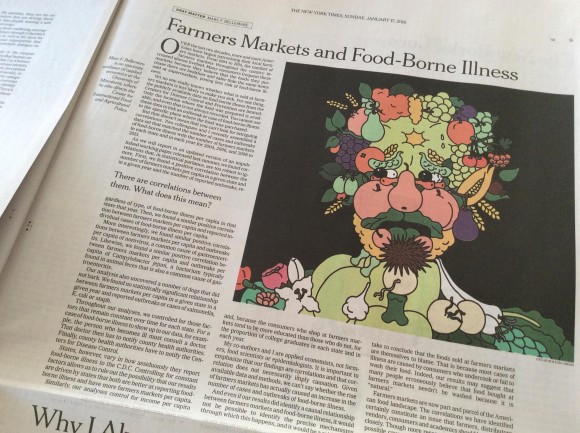Last updated on January 19, 2016
Last summer, I blogged about some work that I had been doing in which my coauthors and I looked at the statistical relationship between farmers markets and food-borne illness.
A few weeks later, I received an email from an editor at the New York Times asking whether I would be interested in submitting an op-ed to the Gray Lady on that same topic. At the time, I was about to embark on several weeks of work-related travel; then, the fall semester hit, with its groundswell of teaching; finally, my household’s dependency ratio went up just before Thanksgiving, all of which left me with little to no time to work on farmers markets.
But recent events about food-borne illness (specifically, the seemingly Chipotle-related E. coli outbreaks) and no teaching this semester (due to being on leave at the U’s Institute for Advanced Study) made me think to get back in touch with the Times editor who asked me for the piece in the first place.
After a good amount of back and forth with folks at the NYT–a process through which I learned quite a bit–what follows (and the picture above) are the first few paragraphs of what came out of it; you can read the whole thing on the New York Times website here. The piece ran in print in the Sunday Review of the Times on January 17.
Over the last two decades, more and more Americans have begun patronizing their local farmers markets. From 1994 to 2014, the number of farmers markets throughout the country increased almost fivefold. Many consumers frequent these markets because they believe that the foods they purchase there are healthier and safer than the same items sold at supermarkets, posing less risk of food-borne illness.
Yet no one really knows whether what is sold at farmers markets is less likely to make you sick. For one thing, the publicly available data on food-borne illness from the Centers for Disease Control and Prevention are limited: Only the location where the food was prepared is available, and even that is not always recorded. You cannot use these data to link an outbreak or case of food-borne illness to the specific place where the food was purchased.
But that doesn’t mean that you can’t look for intriguing correlations. Two colleagues and I recently assembled a data set that matched the number of cases and outbreaks of food-borne illness with the number of farmers markets in each state and in each year for 2004, 2006, and 2008 to 2013.
